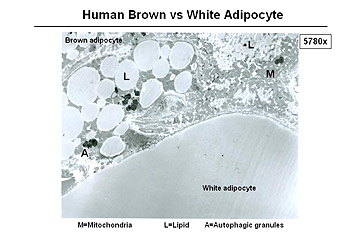
For most people, fat is a burden. It doesn't really matter whether it appears as cellulite on our thighs or cholesterol in our veins — we just don't want it.
But it turns out that our bodies also make a unique form of fat tissue that behaves remarkably unlike any other: rather than storing excess energy, this fat actually burns through it. (See the top 10 food trends of 2008.)
It's called brown fat (as opposed to the more familiar white fat that hangs over belt buckles and swings from the backs of arms), and a series of papers published in the New England Journal of Medicine confirm for the first time that healthy adults have stores of this adipose tissue, which researchers hope to study further as a potential new weight-loss treatment.
Until now, only rodents and human newborns have been known to have any significant deposits of brown fat, so called because of its abnormally high concentration of dark-colored mitochondria, the engines that sustain cell activity. The primary purpose of brown fat is to regulate body temperature: the mitochondria-packed cells are designed to burn high quantities of sugar, the body's fuel, and release that energy as heat — a mechanism that newborns, fresh from the warm confines of the womb, rely on to keep them toasty.
As people age, however, the body becomes more adept at regulating temperature, so brown-fat stores shrink and white fat starts to emerge. (From a biological perspective, brown fat is also highly inefficient, since cells don't need heat to run; rather, they use ATP, another chemical produced by mitochondria.) Adults with appreciable amounts of brown fat are usually those who have certain types of cancer or hyperthyroidism, conditions that stimulate the growth of brown fat. (Read an article about how kids who lack self-control are more likely to gain weight.)
But Dr. Sven Enerbäck at the University of Göteborg in Sweden has shown, using the latest imaging technologies, that healthy adults retain a sizable amount of brown fat in the front and back of the neck. (That was a surprise, since in rodents, the depots tend to be along the back, around the shoulder blades.) Enerbäck and his team studied five patients and confirmed, using genetic analysis, that the cells around the neck were indeed brown fat.
In a sense, scientists have known this for years. While scanning patients with positron emission tomography (PET), an imaging technique often used on cancer patients to detect the spread of tumors, scientists have long noted the excess activity of brown-fat cells in their images. They just didn't realize what they were looking at.
Since PET picks up glucose-burning activity in cells, hot spots on PET scans of cancer patients generally indicate actively growing tumors. But after doing biopsies, doctors found that hot spots in the neck of most of their patients weren't cancerous at all. These turned out to be brown-fat deposits.
"We set forth to actually pinpoint whether the PET glucose-uptake areas corresponded to true brown-fat tissue, and I think we more or less proved the case," says Enerbäck, who found that those mystery cells in the neck expressed the same proteins as brown fat.
Identifying the presence of brown fat is one thing, but activating it to burn more glucose is another. Two studies in the New England Journal of Medicine, including Enerbäck's, confirmed that brown-fat cells become more active in the cold — that is, when study participants needed to boost their body temperature. Enerbäck saw increased activity when he plunged one foot of each volunteer into an ice bath while in the scanner. In a separate study, scientists at Maastricht University Medical Center in the Netherlands also saw upticks in brown-fat activity in subjects who had been chilling in a 16C (61F) room for two hours. (PET technicians have also long known that putting patients in warmer rooms tends to keep that bothersome extra activity from showing up on their images.)
But before we all turn our thermostats down or consider joining the Polar Bear Club, can brown fat actually cause weight loss? Brown fat may indeed shift the balance of calorie intake and expenditure — allowing a person to burn more calories with the same amount of consumption — without the chore of going to the gym or sweating through a workout. "We have very few interventions aimed at increasing energy expenditure," says Dr. Franceso Celi, a clinician at the National Institute of Diabetes and Digestive and Kidney Diseases at the National Institutes of Health. "And here we have a tissue that works exactly with the purpose of burning energy." On the basis of animal models, researchers calculate that 50 g of brown fat — less than what the scientists in the current series of papers documented in their volunteers — could burn about 20% of an average person's daily caloric intake.
In a third study in the New England Journal of Medicine, researchers found that leaner people tended to have more brown-fat deposits than overweight or obese individuals. Interestingly, women were twice as likely as men to have active brown fat, according to the study, conducted by Dr. Ronald Kahn and his colleagues at the Joslin Diabetes Center, Massachusetts General Hospital, Beth Israel Deaconess Medical Center, and Brigham and Women's Hospital.
Still, the findings don't necessarily mean that activating brown fat leads to a trimmer waist. For one thing, the body is especially good at maintaining equilibrium, which is why a boost in calorie-burning can often trigger a hunger signal and prompt people to eat more to make up for the loss. And even if drug companies could find a way to activate brown fat safely, that excess activity could throw off other metabolic systems and damage your health. After all, the people who have the most active brown fat so far are those with cancer and hyperthyroidism.
